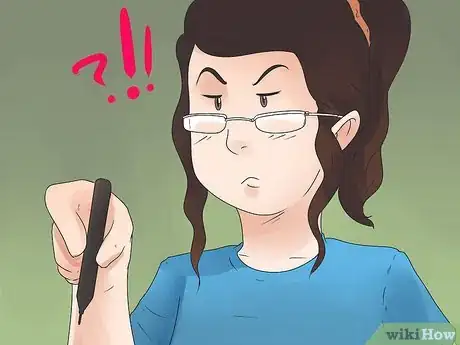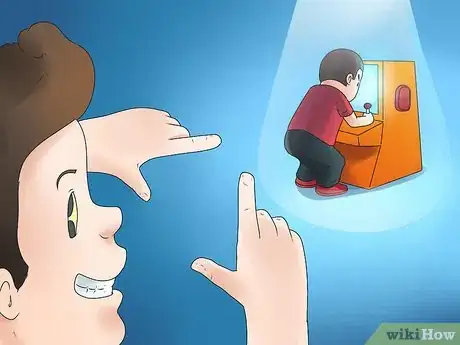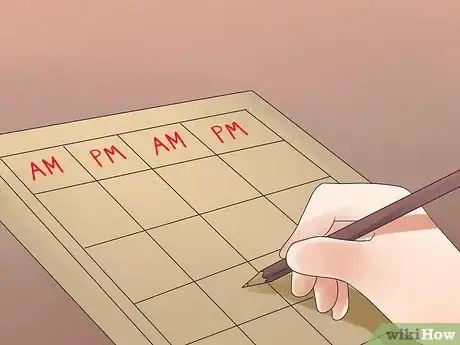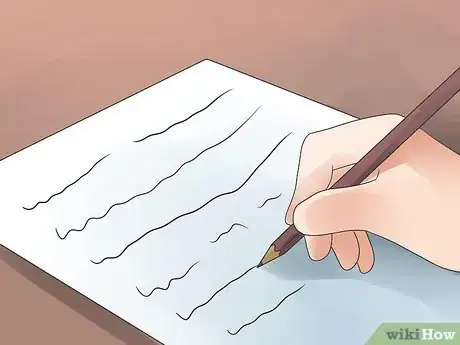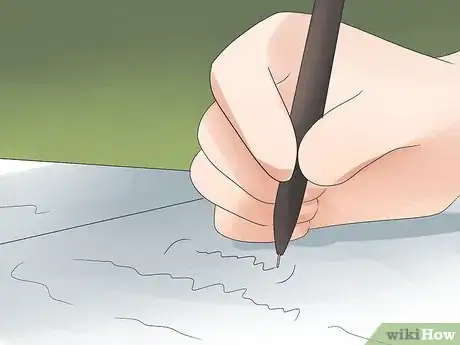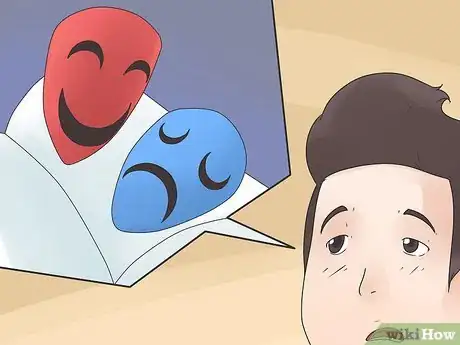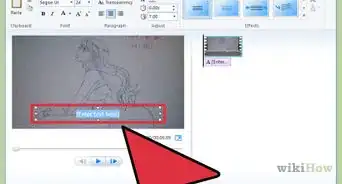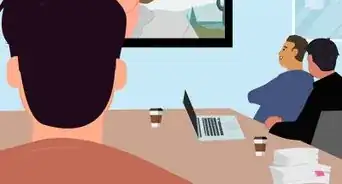This article was co-authored by Stephen Cardone. Stephen Cardone is the COO of NY Headshots, a New York City-based studio that specializes in shooting and producing headshots for individuals and businesses. Stephen has over four years of professional photography experience and over six years of documentary filmmaking experience. Stephen also works extensively as a photographer at NY Headshots. His work includes events, environmental photography, as well as headshots for actors, models, and corporate. He holds a BA in Non-fiction Writing from The New School.
wikiHow marks an article as reader-approved once it receives enough positive feedback. In this case, 100% of readers who voted found the article helpful, earning it our reader-approved status.
This article has been viewed 124,631 times.
Documentary films deal with real people, places, and events, and they're anything but easy to film. Sometimes, the work and planning required to make a good documentary is more arduous than making a drama or a comedy. Because of this, the writing phase of making a documentary is crucial — not only do you have to pick an intelligent, manageable focus for your documentary, but also plan (and even sometimes script) your shooting, all the while making sure that your documentary accomplishes its overall purpose.
Steps
Choosing a Topic
-
1Tackle a hot-button civic or social issue. Some documentaries try to persuade their audience to feel a certain way about a contemporary issue in society by presenting real information that proves the maker's point. This classic approach to writing a documentary gives you the benefit of virtually guaranteed relevance, since it's about something that people probably already have strong opinions about. In addition, the controversy that can be generated from this type of documentary can give you the bonus of added publicity.
- As an example of this type of documentary, check out one of Michael Moore's early documentaries, Roger & Me. In this documentary, Moore paints a tragic picture of corporate greed and the devastating effects that the actions of giant companies can have on local communities by investigating the closure of a GM plant in Flint, Michigan that resulted in the loss of about 30,000 jobs.[1] Regardless of your opinion of the now-controversial filmmaker, it's impossible to deny that the film takes a serious look at the state of modern American capitalism.
-
2Shed light on a little-known subculture. Some documentaries aim to cast light on a small or relatively unknown group of people whose community is quirky, bizarre, gripping, or otherwise fascinating. The subcultures that are the subjects of these documentaries may be made up of people with a common hobby, similar life circumstances, a common background, or some other connection. There's virtually no limit to the types of stories you can tell with these sorts of documentaries — some are funny, some are sad, some are exciting, and some are a mixture of all three.
- As an example of this type of documentary, check out The King of Kong: A Fistful of Quarters. This movie dives into the bizarre world of professional video game players by following the story of a newcomer who hopes to unseat the current champion.[2] This documentary is able to create a compelling story out of the actions of a small group of people who, to most, don't matter at all — quite a feat of documentary filmmaking.
Advertisement -
3Show the intimate side of a famous person. Some documentaries are about the lives of famous or influential people who shaped the world. These documentaries often try to expose the "behind the scenes" trials and tribulations of someone who has a larger-than-life reputation in the public consciousness. The best of these sorts of documentaries use extensive research and interviews with experts or people close to the subject of the documentary to show the audience a side of this person that they're not already familiar with.
- One great example of this sort of biographical documentary is the film Tupac Resurrection. Using home movies and interviews with dozens of people who knew the rap icon (including some with the rapper himself), this documentary humanizes the figure who has since become almost legendary, showing him as a sensitive, intelligent, often conflicted individual.[3]
-
4Document an important event as it happens. Some documentaries give the audience an insider's view into an important event with audacious on-the-ground footage and interviews with the people directly involved in the event. Sometimes, for this type of documentary, the filmmakers "embed" themselves with the people participating in an event. For instance, for a documentary about a war, the filmmakers may travel with a platoon of soldiers, filming day-to-day life on the front and documenting dangerous confrontations with the enemy as they happen.
- Note, however, that these types of documentaries don’t necessarily need to be about grim, serious events. For instance, concert documentaries like Stop Making Sense simply document a band performing live on stage (in this case, The Talking Heads). If well-made, these types of documentaries can be just as captivating.
-
5Expose the dirty secrets of those in power. Some documentaries aim to take on the status quo by exposing the corruption, hypocrisy, and evil actions of powerful people or organizations. These muckraking documentaries generate outrage by showing how the stated goals of those in power differ from the actual outcomes of their behavior. Often, these documentaries will use the stories of individual people negatively effected by the actions of those in power to give a face to the harm caused by the actions of the powerful person or organization. This type of documentary can be especially difficult to make because powerful people will naturally use their resources to resist being painted as greedy, stupid, or evil. However, with determination, lots of research, and daring reporting, it's possible to make a documentary that sparks righteous anger in the audience.
- As an example of this type of documentary, see Hot Coffee. This documentary investigates the infamous story of the woman who sued McDonald's after spilling hot coffee on herself and several other similar stories to show how the media, wealthy corporate interests, and the politicians they bankroll work together to erode the power that ordinary citizens have in the civil justice system.
-
6Dig up new information on historical events. Some documentaries tackle people, places, and events from history, rather than recent or present ones. Because the subjects of these documentaries are often already gone, these types of films rely more heavily on research and interviews with experts (like professors, authors, and so on) than other documentaries. However, it's still possible to tell a compelling story about the past that's relevant to the present by illustrating the link between the two to the audience.
- One recent documentary that does this well is the 2012 film The Act of Killing. This documentary makes powerful statements about the human capability to commit evil by covering the filmmaker's attempts to get the perpetrators of an Indonesian genocide to reenact the mass-killings they participated in.[4]
-
7Show the world something it hasn’t seen before. Some documentaries simply try to capture something exceptionally unique. This can be an event that most people aren't aware of, a person who isn't famous but still has a fascinating life story, or an interesting piece of history that's been lost to time. The best of these types of documentaries make statements use their unique subjects to illustrate larger points about the way the world works or the way people are are.
- One great example of this sort of documentary is Werner Herzog's Grizzly Man. By telling the story of Timothy Treadwell, a man who voluntarily lived in the wilderness of Alaska with grizzly bears and was eventually killed by the bears, Herzog paints a picture of one man's odd relationship with nature that resonates even with audiences that would never consider doing something similar.
Planning and Scripting
-
1Use research to build your documentary’s foundation.[5] The first step to writing your documentary is to educate yourself about your subject as much as you can. Use books, online writings, and especially primary sources (which have the benefit of providing information directly from the people involved in the subject of your documentary) to become an expert on the people, places, and things your documentary is about. Knowing all about your subject makes it much easier to find a compelling "angle" for your documentary to take. In addition, having a good knowledge of your reference material will allow you to know what information you want to present in your documentary (and the sources you should attribute it to).
- If you're unsure of where to start, try going to a local university and contacting a professor who's an expert in the subject of your documentary. Though they may not know everything you want to find out about your subject, they will usually be able to tell you where to look to find this information.
-
2Make your point with a lean, logical progression of information. In their own way, documentaries tell stories with characters, settings, and plots, just like narrative films. Your documentary should have a beginning, middle, and end that work together to convey some sort of logical message or "point" to the audience. In short, your audience should tell a "story" as directly and efficiently as possible. This requires deciding what order to present the information in your documentary to the audience.
- For example, if you're making a documentary about the drug trade between the U.S. and Mexico, you might want to start by establishing a background for your documentary — discussing the creation of the U.S.'s War on Drugs policy, for instance, or showing the path a package of cocaine takes from South America through Central America and Mexico to the United States. You probably wouldn't want to start with an interview with a stuffy professor — just like a normal movie, a documentary should aim to hook the viewer off the bat.
-
3Storyboard the progression of your movie. Though documentaries don't generally have scripts, they should be well-planned.[6] Having a basic outline for the story you want to tell with your documentary can help you plan and schedule your shooting and give you a sense of purpose and direction. A storyboard can also help you visualize the sorts of shots you'll want to use for your documentary. Like an ordinary movie, documentaries can use visual storytelling techniques to make their point to the audience.
- While a storyboard can be a great tool for a documentary filmmaker, it's worth noting that, for some documentaries, some of your footage may come from events that spontaneously occur in front of you. Be open to the possibility of shooting footage without a plan — surprise moments that are captured on camera can make a documentary.
-
4Write an organized schedule. Like ordinary films, most documentaries need a schedule to ensure that shooting stays on-track and that all of the goals the filmmakers are aiming to achieve are met. Your schedule should incorporate any traveling you'll need to do to complete your filming as well as an outline of any important events you'll need to be present at.
- Your schedule should also definitely include a timeline for any interviews you hope to conduct. You'll need to contact the people you want to interview as early as possible to have the best chance of getting their time, so plan the interviews out well in advance of when you plan to begin shooting.
-
5Scrip any narration that will be used for the movie. One part of a documentary that is scripted is any sort of narration in the movie. Voice-over narrators need a script that clearly and efficiently explains the information that the documentary can't convey visually. Even textual narration without a voice-over needs to scripted in advance so that your editor or animator will know what to include in the text.
-
6Script any re-enactments. Some documentaries, especially those about historical figures or events, will include re-enactment segments featuring actors. If these re-enactments include any dialog, the actors will need scripts in advance so that they can practice their line delivery. If there isn't any dialog in your re-enactments, your actors will still need stage directions, which you'll need to write as well.
-
7Be a merciless editor. Don't be afraid to cut anything that doesn't help your documentary prove its point as effectively as possible. If your audience is bored by your film, it will be less receptive to the message you're trying to convey and may "tune out". Keep your documentary as short, snappy, and to-the-point as possible. Anything you edit out can be included in your film's "deleted scenes" on the DVD release, so be picky about what to include and what not to include!
- Note that documentaries don't necessarily have to be feature-length. With the internet, documentaries that are too short for a theatrical run can still be offered as streaming or downloadable video, ensuring your film still reaches an audience.
Giving Your Documentary Purpose
-
1Tell a story with your documentary. As noted above, the best documentaries tell stories that are just as compelling as those you might find in an ordinary movie. This storytelling approach can be used to great effect regardless of the subject of your documentary.[7] The way you write, shoot, and edit your film will affect the way your audience sees your "characters" and reacts to your "plot". Use your movie's narrative to prove your point to your audience. Try asking yourself the following questions as you write and plan your documentary to ensure your film tells the story you want to tell:
- "How do I want my audience to feel about the people and events I'm portraying?"
- "What sort of message am I trying to convey with each scene?"
- "What's the best way to order my scenes to get my desired message across?"
- "How can I use the sounds and visuals of my movie to make my point?"
-
2Aim to persuade the audience. Ideally, your documentary should inspire your audience to act or feel differently than they did before they watched it. Even relatively light-hearted documentaries can benefit from taking this sort of persuasive approach, so never lose sight of the sort of reaction you're trying to create in your audience.
- For some documentaries, like those that tackle controversial social issues, the sort of persuasion you're trying to go for is usually obvious. For others, it may be a little more subtle. For instance, if we're writing a documentary about a strange subculture of people who like to get together and pretend to be unicorns, we might set the goal for ourselves of convincing the audience that even though the hobby these people share is very strange, it still gives them a valuable sense of community that they may not find elsewhere.
-
3Strike an emotional chord. When you get the chance, go for the audience's heart! Proving your point with logic is, of course, highly desirable. However, not every member of the audience will be receptive to pure, unemotional logic. Even the members of your audience who do agree with your film's logic can be further persuaded if they get a serious emotional reaction from the film. Look for opportunities to show the tragedy or humor in the events you're portraying. A truly great documentary will engage the audience's heart as well as its mind.
- For instance, in the example from earlier where we're making a documentary about the U.S.-Mexico drug trade, we may want to include the heartbreaking story of someone who has lost family members to drug-related violence along the border. This gives a human face to the point we're trying to make by showing how a real person's life has been affected by the subject of our documentary.
-
4Sell your audience on the subject matter. Remember, your subject matter is important, even if, in the grand scheme of things, it's actually not! You're making a film about something that has excited, intrigued, or captivated you, so make it your goal for your film to have the same effect on the audience as the subject matter has on you.
- For instance, in The King of Kong: A Fistful of Quarters, the central conflict between the newcomer to the world of competitive video gaming and the reigning champion is something that seriously matters only to a tiny, insignificant group of people. However, because the filmmakers portray it as a quirky underdog tale, it's actually surprisingly exciting to watch. The audience gets wrapped up in the competition even though, in the end, the only thing at stake is bragging rights in a ragtag group of video game aficionados.
Expert Q&A
-
QuestionHow do you write a documentary script?
 Stephen CardoneStephen Cardone is the COO of NY Headshots, a New York City-based studio that specializes in shooting and producing headshots for individuals and businesses. Stephen has over four years of professional photography experience and over six years of documentary filmmaking experience. Stephen also works extensively as a photographer at NY Headshots. His work includes events, environmental photography, as well as headshots for actors, models, and corporate. He holds a BA in Non-fiction Writing from The New School.
Stephen CardoneStephen Cardone is the COO of NY Headshots, a New York City-based studio that specializes in shooting and producing headshots for individuals and businesses. Stephen has over four years of professional photography experience and over six years of documentary filmmaking experience. Stephen also works extensively as a photographer at NY Headshots. His work includes events, environmental photography, as well as headshots for actors, models, and corporate. He holds a BA in Non-fiction Writing from The New School.
Professional Photographer Most documentaries don't have scripts, however, you can create a solid outline for your film to help guide production. Do plenty of research on your subjects to figure out what the main story is and what questions you want to ask. Your story may evolve as you do interviews and learn more information. That's okay! Just adjust your outline accordingly.
Most documentaries don't have scripts, however, you can create a solid outline for your film to help guide production. Do plenty of research on your subjects to figure out what the main story is and what questions you want to ask. Your story may evolve as you do interviews and learn more information. That's okay! Just adjust your outline accordingly. -
QuestionCan I shoot a good documentary without a script?
 Community AnswerYes, many documentaries do not use a script. If you want your documentary to have a raw, uncut feet, this is a good option.
Community AnswerYes, many documentaries do not use a script. If you want your documentary to have a raw, uncut feet, this is a good option. -
QuestionHow do I make a mockumentary?
 Isabel WillemsCommunity AnswerWatch some real documentaries and find the things that they all have in common. Maybe it's the narrator's voice or the shots that they use. Now exaggerate those things immensely, showing clearly that you are making fun of documentaries while still pretending like you're a serious documentary.
Isabel WillemsCommunity AnswerWatch some real documentaries and find the things that they all have in common. Maybe it's the narrator's voice or the shots that they use. Now exaggerate those things immensely, showing clearly that you are making fun of documentaries while still pretending like you're a serious documentary.
References
- ↑ http://www.imdb.com/title/tt0098213/
- ↑ http://www.imdb.com/title/tt0923752/
- ↑ http://www.imdb.com/title/tt0343121/?ref_=fn_al_tt_1
- ↑ http://www.imdb.com/title/tt2375605/?ref_=fn_al_tt_1
- ↑ Stephen Cardone. Professional Photographer. Expert Interview. 26 June 2020.
- ↑ Stephen Cardone. Professional Photographer. Expert Interview. 26 June 2020.
- ↑ http://www.writersstore.com/documentary-storytelling-the-drama-of-real-life/
- ↑ Stephen Cardone. Professional Photographer. Expert Interview. 26 June 2020.
About This Article
To write a documentary, start by choosing a topic that people will have strong opinions about, like the drug trade between the U.S. and Mexico. Then, plan out your documentary with a logical progression that builds up to a clear message, and make sure to start with an introduction that hooks the viewer right off the bat. For example, start your documentary by showing the path that a drug shipment takes from Mexico to the U.S., followed by background information, like the creation of the U.S.’s War on Drugs policy. For more advice, including how to shoot and edit your documentary, keep reading.
